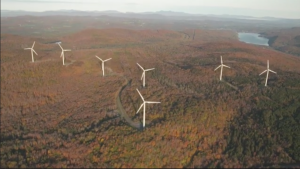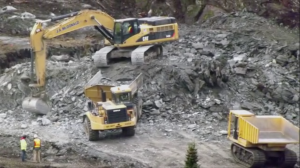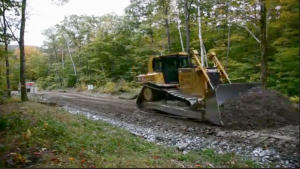Posted April 29, 2016
By ROBYN SHAPIRO
Wind turbines on Vermont ridgelines near residences have proven to be unbearable for some Vermonters. The flooding issues, habitat devastation and incessant revolving make their long time homes intolerable.
In the documentary “Vermont’s Energy Options” Paul Brouha, a neighbor to the Sheffield Wind Project stated that after they had fought the Vermont state government on the project, “it was like we weren’t even there.”
The government decided to continue the project after they had attorney representation, a zoology professor from the University of Vermont testify the environmental damages and animal impact, and the state economist testify that there was not going to be a large economic benefit.
For the past 20 years, Vermont has made an energy transformation to renewable energy as a result to the acknowledgement that big base load power fired by coal, nuclear and natural gas has a negative impact on the environment.
While many Vermonters and the Vermont state government agree that renewable energy is essential to our survival, the some methods of energy production, specifically wind, have been more hurtful than they have been helpful.
The Vermont state government feels that we need to solve the problem of fossil fuel consumption as quickly as possible. While in theory this is noble, independent, non- government environmental organizations such as Energize Vermont feel that we need to evaluate the all of our alternative energy options, to avoid hurting our existing environment and fully utilizing our resources.
Historically, Vermont is a very progressive state. It is socially liberal and on the cutting edge of technology for alternative energy to fossil fuels. It is the home of presidential candidate Bernie Sanders, a self-proclaimed socialist who is one of the state’s two U.S. senators.
The documentary, “Vermont’s Energy Options” created by Energize Vermont uses credible resources such as Ben Luce, environmental activist and physics professor at Lyndon State College, Geoff Goll, hydrologist for Princeton Hydro, Steve Wright, former commissioner of the Vermont Fish and Wildlife Board, Susan Morse, wildlife ecologist, and other passionate and educated Vermonters, to discuss the issues with wind power in Vermont. Created in 2012, many of the issues are still prevalent and unrevised.
In “Vermont’s Energy Options”, the current Vermont Governor, Peter Shumlin, said at the Sheffield wind turbine rally:
“The Energy Innovation Program (EIP) I proposed in my inaugural address will position us to take advantage of this opportunity, helping to create jobs, keep young Vermonters here in the state, save Vermonters money on energy bills, and do what’s right for the environment.”
So why don’t these Vermonters want wind turbines in their backyards?
As the Vice President of Energize Vermont, Luke Snelling, stated, “using wind power in Vermont means huge natural resource impacts and very little gain.”
In the documentary, Shumlin stated at the Sheffield wind turbine rally that while he was in office for only 10 months, he had dealt with three large floods that had destroyed some of Vermont’s towns and because of this, “we have to build renewable energy as fast as we know how”
While this fact maybe be true, in “Vermont’s Energy Options” hydrologist Geoff Goll opposes Shumlin by stating that when building these turbines on the ridgelines, dozens of roads are created to go up untouched land, and by doing this it changes the natural progression of water flow, increasing flooding.
Wildlife ecologist Susan Morse states in the documentary, massive habitat devastation occurs when dynamite is used to blow the tops of ridgelines to place the turbines. It is important to maintain core connectivity of habitats in order to provide a way for animals to adapt to climate change.
Building wind turbines destroys core connectivity because it will break up their existing habitats making it more difficult for them to adjust. “Vermont’s Energy Options” also emphasizes that people suffer from low frequency vibration, causing sleep deprivation and other health issues.
While many Vermonters are aware of these problems, much of the issues that Energize Vermont and other Vermonters have with wind turbines revolves around a piece of legislation called Title 30, Section 248.
This law is rarely used and is meant for large installations, like power plants. It basically states that if the installation benefits all of Vermont as a whole, it can be utilized despite environmental impacts or potential impacts on smaller communities. This law can be utilized for projects like transmission lines so that power can be used though out Vermont.
The state Public Service Board, which is appointed by the governor, decides the legitimacy of the projects. As modern technology progresses and alternative energy becomes more prevalent, this law becomes more of an issue.
In the 1980s, Act 250 was attached to section 248, which attempted to give local governments more say.
Ultimately, Act 250 mandated that the Public Service Board just needed to state why they would not consider opposition of local government rather than blatant disapproval. It did not say that local government had any more power.
This law restricts the say of local government, so when large establishments are placed, such as the Lowell Wind Project, local government and townspeople have virtually no say on it.
Current Chair of the Vermont House of Natural Resources and Energy Committee and Chair of the Joint House and Senate Energy Oversight Committee, Tony Klein stated that S230 is currently being added to Title 30 Section 248 to address some of these problems. S230 allows towns to have substantial deference before the Public Service Board.
Klein states that “the difference between now and before, the town had to show why the project was not a good fit, the burden of proof was on them- now when they substantial deference, the developer has to prove why they should trump the towns plan… that’s really good for the towns.”
However, in the end, the public service board still has the final say.
Where Energize Vermont and the Vermont state government do agree is that they both want the renewable energy they produce to benefit their home state.
Each New England state has a Renewable Energy Portfolio for their energy companies. This means a certain amount of energy used must be renewable. While one way to satisfy this is to make renewable energy, another is to buy Renewable Energy Credits (RECS), which say that you bought the use of that renewable energy. Vermont sells a large number of these credits to states like Connecticut and receives a large sum of money.
“I would like it to be more direct,” said Vermont Rep. Robin Chestnut Tangerman, who serves on the House Committee on Natural Resources and Energy, the Government Accountability Committee and the Joint Energy Committee. “There should be no question about if you’re generating solar power that its renewable power, as a opposed to selling the ‘renewableness’ to someone else.… I’m not a big fan of the REC sales.”
“The way the system is working now Vermont is benefiting, but if New Jersey can keep buying dirty coal power from West Virginia but then buy Vermont wind RECS, then it’s all okay. It’s kind of a white wash, because there is still coal power being generated and their buying it. They’re just taking the renewable attributes of Vermont’s power and putting it on the dirty coal power and going ‘oh now its green’,” he added.
Founder of Energize Vermont, Annette Smith, also referred to this system as a “whitewash” that covers the fact that these plants are just buying their way to satisfying their portfolio standards, rather than using actual renewable energy.
Overall, while both parties may agree that renewable energy is essential to implement, the disagreement lies in the preferred mechanisms to produce renewable energy and the allocation of power within the local, state and the federal government.



